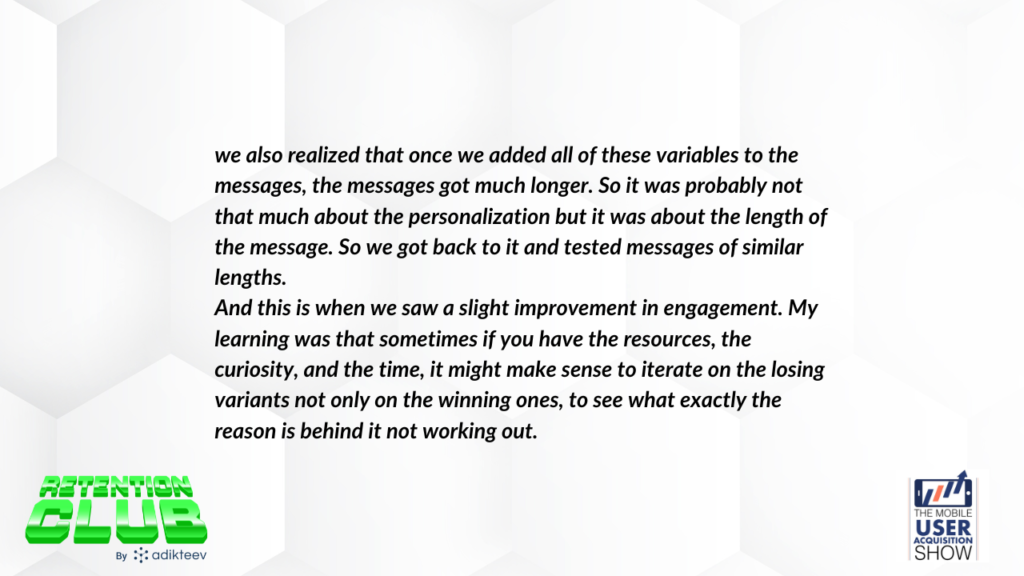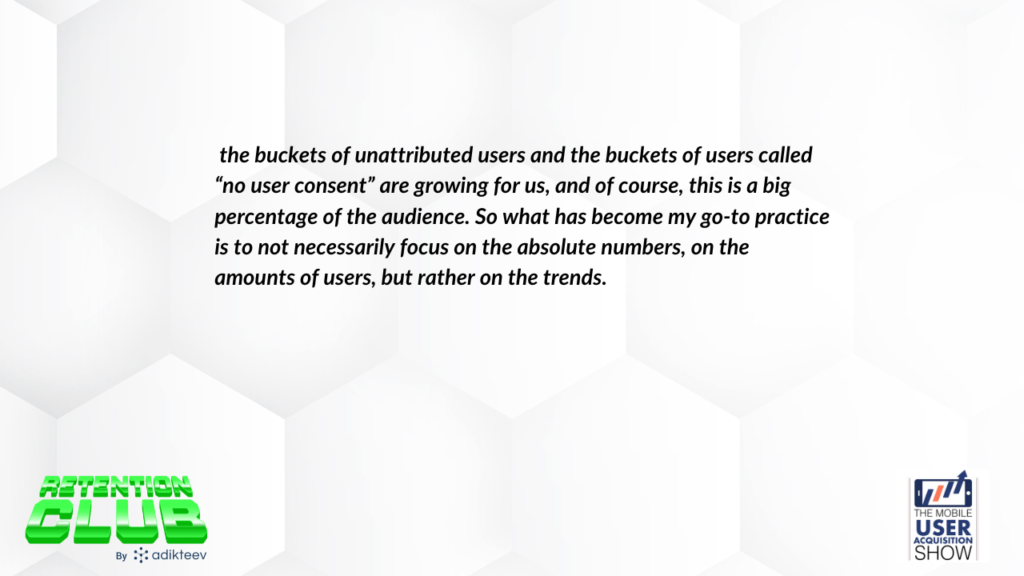
Our guest today is Ekaterina Gamsriegler, Head of Growth and Marketing at Mimo – an app that helps people learn coding.
In today’s episode, we delve into retention triggers, managing seasonality and usage spikes, when and how to use paid retargeting, understanding retention by channel – and much much more.
This episode is a part of the Retention Club, a series of episodes that are co-produced along with Adikteev.



ABOUT EKATERINA: LinkedIn | MIMO
ABOUT ADIKTEEV: Website | LinkedIn | Retention Club
ABOUT ROCKETSHIP HQ: Website | LinkedIn | Twitter | YouTube
FULL TRANSCRIPT BELOW
Shamanth
I’m excited to welcome back Ekaterina Gamsriegler to the Mobile UA Show and also to the Retention Club segment around retention and re-engagement this week. Ekaterina, welcome to the show.
Ekaterina
I’m very happy to be here again.
Shamanth
To get started, in our first briefing call, you talked about how important it is to align internal and external triggers for improving retention.
Can you give examples of how apps have successfully implemented using internal and external triggers?
And perhaps also a situation where things didn’t go as planned, but were still valuable in offering lessons.
Ekaterina
I’ll start with maybe an overview of how I approach it and then share some examples as well. The concept of internal and external triggers is not so new. Ideally, everybody knows it by now.
External triggers are everything that happens outside of apps externally and motivate users to get back to using the product. Internal triggers would be our emotions, feelings, and fears. So typically the way it works is that you double down on external triggers till the users have this internal motivation to start coming back to your product until they build a habit.
In my experience, what works particularly well is to not necessarily wait until this moment, but to look into the product usage to check what are the typical patterns, what is the average frequency, and when are the spikes and the low points in usage. These kinds of spikes would be the moments when it might make sense to double down on external triggers as well which can be emails, push notifications, retargeting ads, for example.
Let’s say we’re talking about an educational app, then we can see that there is a clear pattern and users mostly use the product during the weekdays and have a slight drop over the weekend.
At the same time, we might have a closet organizer app and users are most likely to have the time to work on it during the weekend. This would be the time when it makes sense to additionally encourage product usage. So this would be roughly the idea of how one can approach it. Like looking at the app, to map the trends and patterns and using the app with the communication.
One time at Mimo where it did not work out for me was a couple of years ago, in addition to sending in daily reminders we also wanted to see if sending in weekly educational tips about programming languages and practices would help us improve retention. And it really did not.
However, it was still a win for us because we did not invest more resources into coming up with the whole setup like the content, which would have to differ week over week. So this is how we figured that we should rather double down on the daily reminders.
I have another story. We tested at some point whether personalizing the daily push notifications helps us improve the engagement rates with the pushes. We had the control group and the test group, the test group would receive notifications, which would include the user’s name, the programming language they’re learning, their current streak, and maybe the name of the lesson and we saw that they did not perform any better and sometimes even worse than the original messages.
But later on,

Shamanth
Sometimes a variable that led to it losing might be something you haven’t expected. And that can certainly be the case.
We were talking about some of the recent changes to email and spam policies. How do you see these changes impacting the broader CRM and retention space?
Ekaterina
To be honest I’m really curious if this will in any way come true. What I think might be happening in the short term is first of all apps redesigning the marketing lead and retention strategies and mostly the email flows to only keep the emails that are actually relevant and valuable for the audience.
With this, I also already see more and more products implementing the little set of links in the footer which are asking whether the email was helpful or not so helpful, etc
This is already one of the filters that can help you remove the emails in the journey, which might have high spam rates. Another change I would expect to happen is that instead of just focusing on the email as a channel, we will build much more elaborate multi-channel retention strategies, which will also include push notifications in-app messages and for some apps SMS that might be relevant as a channel, for example, FinTech apps. Everybody has also started implementing the double opt-in policies.
My biggest fear is that there will be some kind of a domino effect when let’s say everybody starts doubling on push notifications now and an average user already receives 50 a day. This part of the experience is even more cluttered and harder to stand out. The personalization relevancy and more advanced segmentation will be taking place.
And now as we have machine learning and AI tools this should be getting implemented early.
So honestly, I believe on one hand, our job will become harder because it will be really hard to stay below the spam thresholds and to make sure that your content is even more relevant, personalized, and valuable.
On the other hand, a lot of the products and players will end up in the spam folder, because they were maybe through the emails and all the mass discount sale campaigns artificially trying to boost the demand and stay top of mind might make it a little bit easier for other players to finally make sure that the emails get attention in the inbox because a bunch of others will end up in spam.
Shamanth
And it’s hard to see how this could eventually play out, but you’re right. This could potentially level the playing field, but suddenly it could just definitely be disruptive in ways we haven’t completely envisioned. Can you talk about how usage spikes to tailor any CRM communications around them?
So for instance, that could be weekends, specific days of the week, or even times of the year.
What do you think about having re-engagement efforts tailored to usage spikes or lulls?
Ekaterina
My go-to framework for this one would be the BJ Fogg behavioral model.
It has three elements in it. It’s about motivation, prompt and ability. So the first element here is to make sure that the communication aligns with the user’s motivations, whether internal or external.
The second element is the ability. The communication should be timely. It should arrive at a good moment for the user when the user is also in the right context to receive this communication and to be pulled back into the product.
So my go-to tips and best practices that I have so far. First it’s really good to enable the user to pick up the reminder time. For example, we aim at building a habit, which means using the products daily. In this case this means sending daily emails or push notifications, we send push notifications only. So it’s a good practice to enable the user to pick the time when they should get reminded about the lessons.
Then if you cannot enable users to do that also, a good rule of thumb is to send the reminders 24 hours after the engaged session, personalizing these messages with very clear and short pull to action again as we have tested it extensively. In our case, short and clear messages work best. So for example instead of saying “Give yourself a boost”, it works much better when you say, “Start your free trial”, “You’re eligible for a free trial” or things like that.
Another thing to increase the ability part of this equation is to also send the messages in the user’s time zone so that it’s not the middle of the night and the users can act on it.
A good example here would be trading apps. I used to work for one for several years. This for me was the case when the communication was a hundred percent aligned with the user’s motivations. You could allow a user to set reminders during volatile times, like the price for the product that they’re trading either changes by a certain extent, either increases or decreases.
This is very clearly aligned with monitoring gains and losses, which means these are the types of notifications that are extremely useful for the user.
This is where the engagement rates are typically the highest. This hugely depends on the nature of the app, of course, but they are saying this motivation alignment was the strongest, this was the best use case for relevant communication.
Shamanth
And it also allows the user to customize and pick what kind and type of notification might make sense for that, which makes a lot of sense. That’s why we’ve been talking about using push and email and organic ways of retargeting.
But you also worked with paid retargeting and you talked about a former company that you worked at, which had a fairly interesting approach to paid retargeting campaigns, specifically to ensure that these were incremental, that they were ROAS positive.
Can you describe this approach?
Ekaterina
This was several years ago. Now with the privacy changes, it is much more tricky to execute something so elaborate. But what we were doing was to first, have multiple segments for a target team. We would have a segment of users who signed up but did not start the trial. Then another segment for started the trial, and didn’t make a purchase, etc. For each of the segments, it would be a separate campaign with a separate set of creatives, incentives and discounts. So depending on the drop-off stage and the user journey, we would tailor everything to that.
The most interesting element here was that we would not run this retargeting campaign right away. We would look at when for every cohort was the natural drop in conversion events. So for example, if we see that 90 percent of users purchased within the first 14 days after installing the app then starting day 15, we can launch retargeting campaigns.
This was to avoid cannibalization and to have some proper incrementality there. And to also just use other methods like CRM and communication to convert the users within this time frame. If all fails, then we would try with external triggers like retargeting ads.
Shamanth
I would say you’re right that the privacy changes have complicated this approach a lot more, but I would say a lot of folks I know are using a very similar approach just with opted-in users in being able to retarget them. And what I also find interesting is that approach.
To describe like a fairly close mirror image of how an effective organic CRM campaign would be set up. Because you would set up emails, and push notifications to go out by user segment, and have customized incentives for each of them. So this makes sense in terms of mirroring how an organic setup would be.
When you’re understanding retention and re-engagement, I would imagine that the retention of a user is a very significant function of the channel that they installed the app from, so I would imagine understanding retention by channel becomes critical.
Again, post privacy changes, it’s no longer as clear-cut or easy to understand. What do you think about understanding retention by channel? And what, if any, might be insights that you may have gotten by trying to understand retention by channel?
Ekaterina
You’re completely right,

So once you have the picture of what’s happening with the product acquisition-wise, if there were any features, if you launched new channels or maybe scaled down some high-quality channels, so basically you’re aware of the changes that are happening when it comes to the quantity and quality of the users.
If there is no significant change, then I think it’s fair to rely on the trends. So just look at how the retention rates for the channels you have the attribution data for keep developing. So basically for me, looking at day one, day three day seven retention, and the percentage of activated users per channel still makes sense in this regard.
This still makes it possible to gather insights. For example, search channels like Apple Search Ads, Search Ads or Google Organic Search have the best retention rates. For me, what’s often surprising is that influencer partnerships perform quite well also retention-wise like the retention rates are very similar to search channels performance.
We also have TikTok, which is also surprisingly good. And maybe the not-so-positive one is the traffic from the referral programs. This is where I tend to see maybe 30 to 40 percent lower retention rates compared to the users who come organically or via paid acquisition. So this is still possible.
You’re not probably going to get super granular insights per cohort but you can get a good idea of the trends and also see whether changes in your acquisition mix make a difference.
Shamanth
You’re right that it’s never a precise measurement, but it is possible to get a fairly good read of how each channel’s retention is and how it’s impacting longer-term, engagement of a user, the longer-term LTVs of a user. Sometimes you can just see that when you turn on a channel, your overall retention is not great, and you know that is the cause of it.
Sometimes it’s less clear, but there are ways to tease that out to understand what, I think, is happening with your apps.
Katya, I think this has been very insightful especially since you are looking at all parts of your growth stack, acquisition, retention, monetization, and it’s very interesting to understand and see how we are looking at some aspects of retention.
This is perhaps a good place for us to wrap up. But before we do that, can you tell folks how they can find out more about you and everything you do?
Ekaterina
I’m trying to be more active on LinkedIn. This is the best place to find me for different marketing and growth-related tactics and insights.




